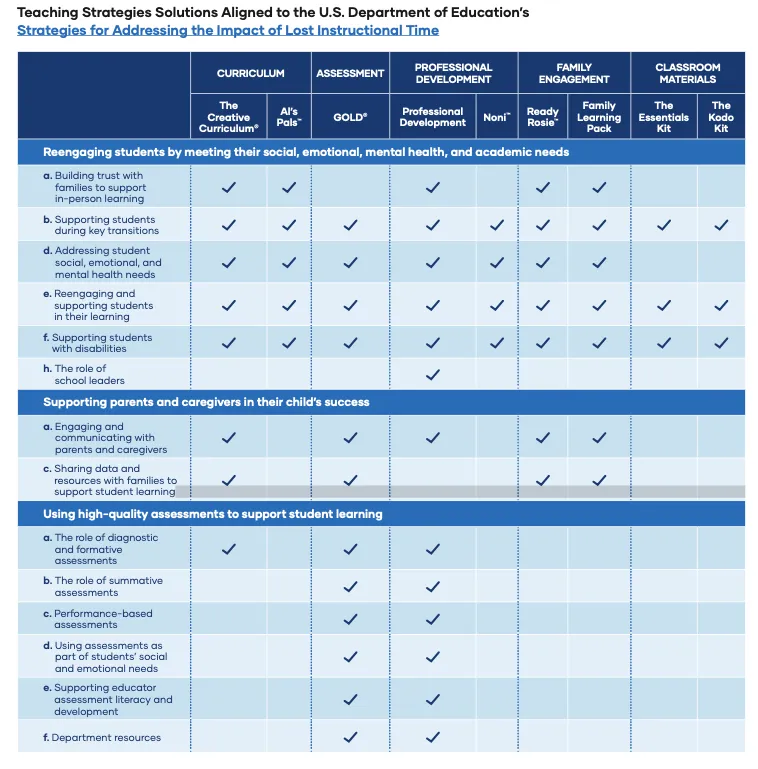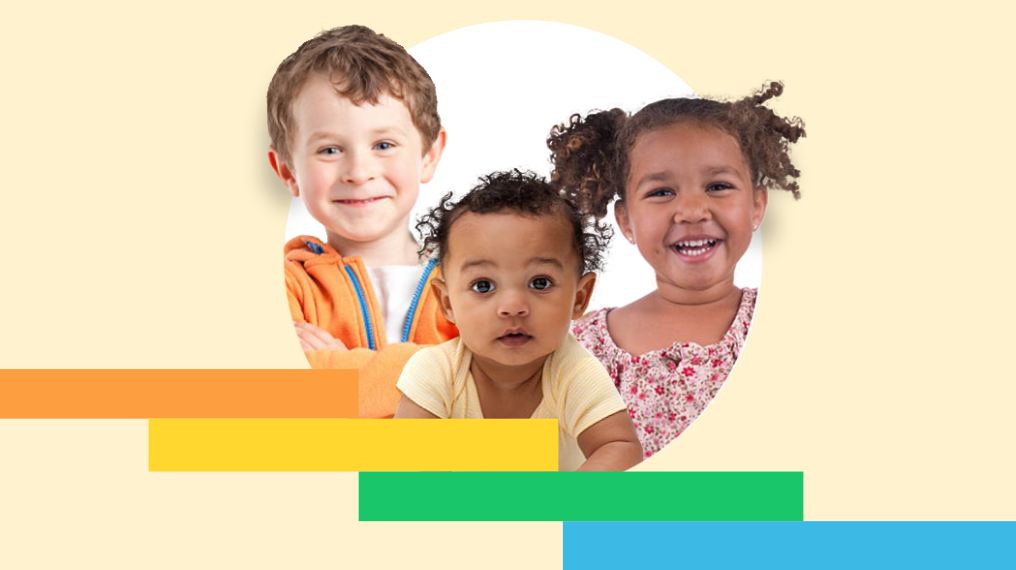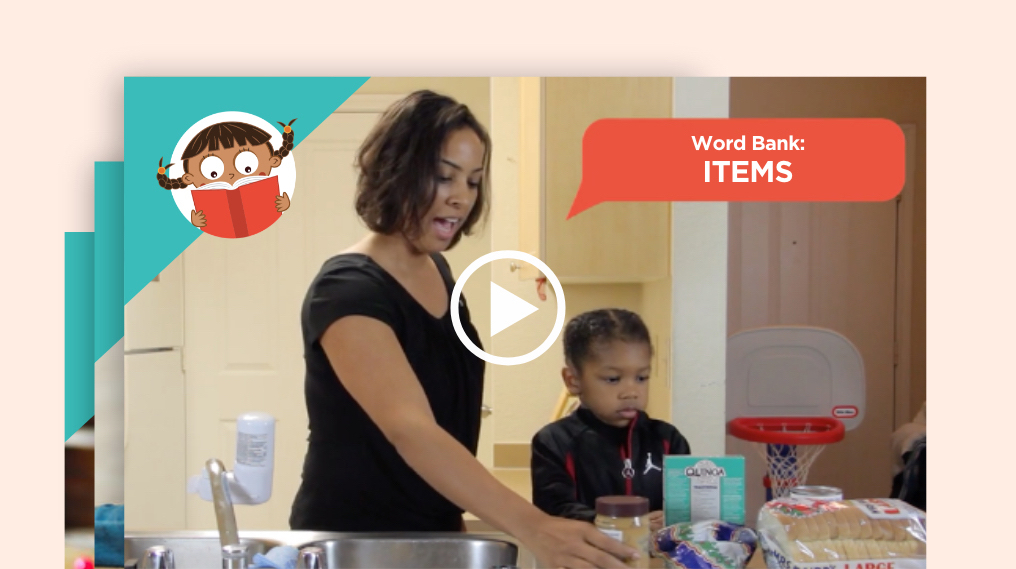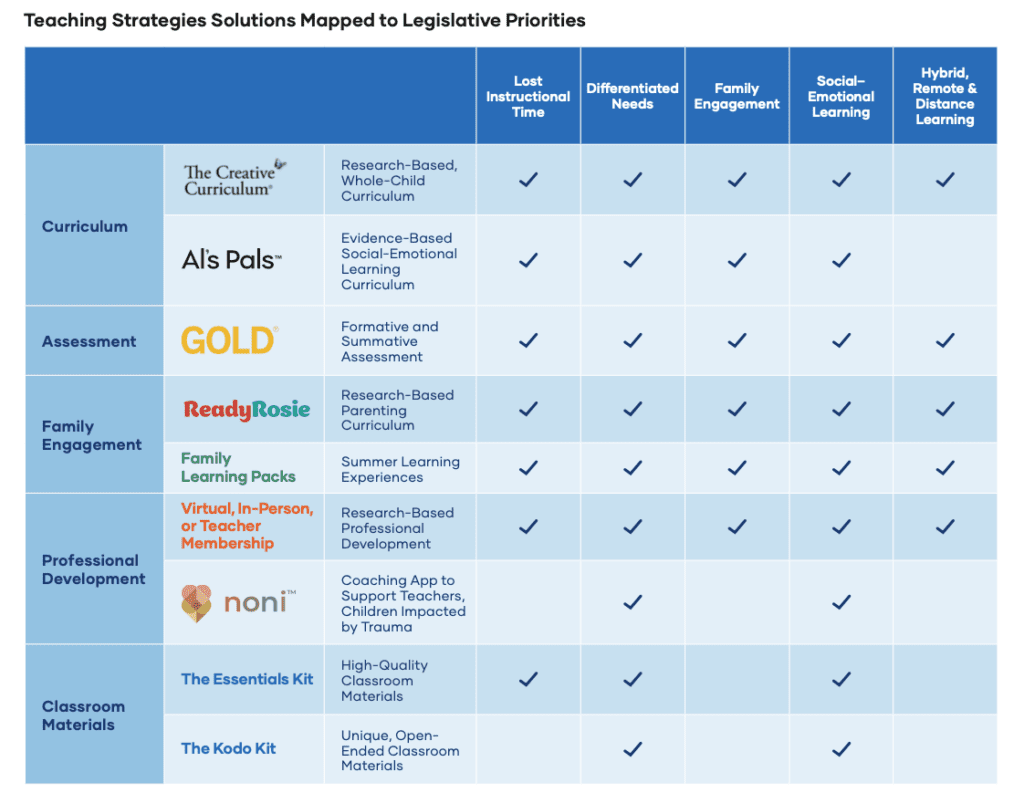6 Ways You Can Leverage ESSA & ESSER Funds
Deliver Individualized, Whole-Child Instruction
Prepare children for success in school and in life with the leading research-based, whole-child curriculum built for early childhood educators with The Creative Curriculum for Infants, Toddlers & Twos, The Creative Curriculum for Preschool and The Creative Curriculum for Kindergarten.
Provide Educators with High Quality Classroom Materials
Ensure children and teachers have equitable access to the materials they need to seamlessly guide and engage in meaningful daily learning experiences with The Essentials Kit and The Kodo Kit.
Build Powerful Family Partnerships
Strengthen the connections between school and home by better engaging all families with evidence-based and research-based family engagement with ReadyRosie and our Family Learning Pack.
Boost Social-Emotional Learning
Build the foundation children need for success in school and life with Al’s Pals, a nationally recognized evidence-based social emotional learning curriculum.
Improve Teaching with High-Quality Professional Development
Build and strengthen teacher capacity and professional growth to ensure your program can provide children with the kind of learning environments and experiences they deserve with Professional Development from Teaching Strategies and provide your educators with in-the-moment support to help build trauma-sensitive classrooms with Noni.
Combat Learning Loss and Drive Differentiated, Effective Instruction
Inform instruction without disruption by embedding authentic, observation-based assessment into each part of your day with GOLD. Formative Assessment made easy for teachers and powerful for administrators.
See How Our Solutions Map to Funding

Title I Funding
How the funds can be used: Title I, Part A is a $15 billion annual account that provides supplemental support to schools with high concentrations of students of poverty. The funds flow according to the number of students of poverty in the schools. Schools use the funds to ensure that all children receive a high-quality education and to close achievement gaps. The funds can address the needs of all children in the school, but particularly the needs of those at-risk of not meeting the challenging state academic standards.
How Our Solutions Help: Teaching Strategies’ tools strengthen academic programs and improves conditions of learning through implementing a well-rounded program of instruction, facilitating effective transitions for students across grade spans, and helping students meet state academic standards.
Teaching Strategies Solutions Qualifying for Title I Funds:

Title II Funding
How the funds can be used: Title II, Part A is a $2 billion annual account that provides funding to states and districts to improve the quality and effectiveness of teachers, principals, and other school leaders. The bulk of the funds (95%) are for districts to support evidence-based, personalized, professional development in schools and to support effective professional learning programs. These funds can support all subjects and teachers.
How Our Solutions Help: Teaching Strategies’ Professional Development offerings and teacher resources offers participants a robust set of tools.
Teaching Strategies Solutions Qualifying for Title II Funds:

Title III Funding
How the funds can be used: Title III, Part A is an annual $737 million account that supports effective language instruction programs to improve the education of English learners (EL) and immigrant youth by helping them to learn English and meet the same challenging academic standards as other students.
Districts use the funds to (1) carry out professional development to improve English Learner language instruction, (2) provide a language instruction educational program (LIEP), and for (3) parent, family and community engagement (FACE) activities.
How Our Solutions Help: Teaching Strategies can help improve instructional programming for ELs through culturally relevant parent engagement, content and pedagogy, and other adaptable features.
Teaching Strategies Solutions Qualifying for Title II Funds:

Title IV Funding
How the funds can be used: Title IV Part A is a new $1.1 billion block grant that supports the work of Title I, II, and III with supplemental funding for one of three broad activities:
(1) well rounded educational programming;
(2) ensuring a safe and healthy learning environment; and
(3) the effective use of technology by students and staff in the schools.
Up to 25% of the amount used for the effective use of technology may be for purchasing technology infrastructure (including software).
How Our Solutions Help: Teaching Strategies’ offerings support all priorities outlined in ESSA for:
- Well rounded educational programming;
- ensuring a safe and healthy learning environment; and
- the effective use of technology by students and staff in the schools.
Teaching Strategies Solutions Qualifying for Title I Funds:
ESSER Funding
How the funds can be used: School districts can spend ESSER funds to minimize the spread of COVID-19 and prepare for future outbreaks, address long-term school closure, remedy learning loss among students due to the COVID-19 pandemic, support student mental health and support staff. Check out our Quick Guide to Investing in Early Learning Using ESSER Funding.
How Our Solutions Help: The Teaching Strategies connected ecosystem of curriculum, assessment, professional development, family engagement, and social–emotional resources supports many of the priorities of ESSER funding and can help you create powerful early learning experiences that are more effective, more efficient, and more accessible to everyone.
Teaching Strategies Solutions Qualifying for ESSER Funds:

At a Glance
Learn more about how you can utilize ESSER funds to accelerate learning and elevate your program with Teaching Strategies’ solutions with our free product mapping cheat sheet.
Use ESSA & ESSER Funding to Elevate Your Early Childhood Education Program With Teaching Strategies
The Creative Curriculum for Infants, Toddlers & Twos
Nurture the unique strengths, interests, and needs of the youngest learners.
The Creative Curriculum for Preschool
Build children’s confidence, creativity, and critical thinking skills, through hands-on, project-based investigations.
The Creative Curriculum for Kindergarten
Encourage all children to think critically, solve problems, and connect ideas. When kindergarteners investigate, discover, and play, they learn.

GOLD
Move beyond measurement and drive differentiated, effective instruction. Inform instruction without disruption by embedding authentic, observation-based assessment into each part of your day.

Al’s Pals
Young children need resiliency now, more than ever. Boost social–emotional learning to prepare children for life’s challenges.
Family Learning Pack
Revolutionize learning this year with the Family Learning Pack—a learning adventure designed to empower families and children and elevate their role in school readiness, featuring ReadyRosie and MarcoPolo Learning.

ReadyRosie
Better serve and engage all families with a research-based framework and video modeling to extend and reinforce learning.

Professional Development
Build and strengthen teacher capacity and professional growth to ensure your program can provide children with the kind of learning environments and experiences they deserve.

Classroom Materials
Ensure children and teachers have equitable access to the materials they need to seamlessly guide and engage in meaningful daily learning experiences with The Essentials Kit and Kodo Kids.

Noni
Create trauma-sensitive, relationship-focused learning environments to mitigate the impact of trauma and adverse childhood experiences (ACEs) on young children.





